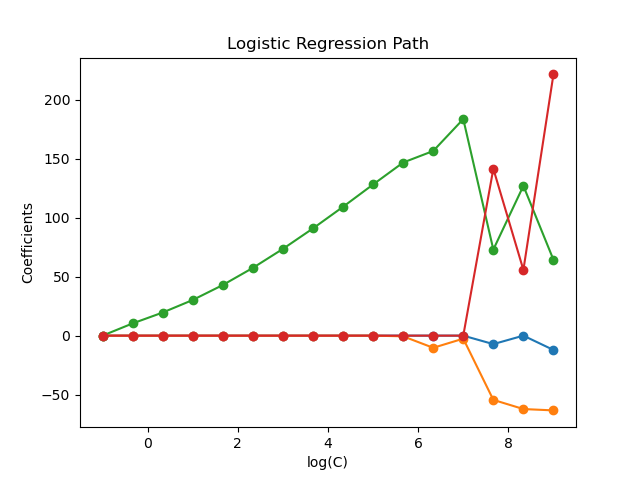Regularization path of L1- Logistic Regression (original) (raw)
Note
Go to the endto download the full example code. or to run this example in your browser via JupyterLite or Binder
Train l1-penalized logistic regression models on a binary classification problem derived from the Iris dataset.
The models are ordered from strongest regularized to least regularized. The 4 coefficients of the models are collected and plotted as a “regularization path”: on the left-hand side of the figure (strong regularizers), all the coefficients are exactly 0. When regularization gets progressively looser, coefficients can get non-zero values one after the other.
Here we choose the liblinear solver because it can efficiently optimize for the Logistic Regression loss with a non-smooth, sparsity inducing l1 penalty.
Also note that we set a low value for the tolerance to make sure that the model has converged before collecting the coefficients.
We also use warm_start=True which means that the coefficients of the models are reused to initialize the next model fit to speed-up the computation of the full-path.
Authors: The scikit-learn developers
SPDX-License-Identifier: BSD-3-Clause
Load data#
from sklearn import datasets
iris = datasets.load_iris() X = iris.data y = iris.target feature_names = iris.feature_names
Here we remove the third class to make the problem a binary classification
X = X[y != 2] y = y[y != 2]
Compute regularization path#
Create a pipeline with StandardScaler and LogisticRegression, to normalize the data before fitting a linear model, in order to speed-up convergence and make the coefficients comparable. Also, as a side effect, since the data is now centered around 0, we don’t need to fit an intercept.
clf = make_pipeline( StandardScaler(), LogisticRegression( penalty="l1", solver="liblinear", tol=1e-6, max_iter=int(1e6), warm_start=True, fit_intercept=False, ), ) coefs_ = [] for c in cs: clf.set_params(logisticregression__C=c) clf.fit(X, y) coefs_.append(clf["logisticregression"].coef_.ravel().copy())
coefs_ = np.array(coefs_)
Plot regularization path#
import matplotlib.pyplot as plt
Colorblind-friendly palette (IBM Color Blind Safe palette)
colors = ["#648FFF", "#785EF0", "#DC267F", "#FE6100"]
plt.figure(figsize=(10, 6)) for i in range(coefs_.shape[1]): plt.semilogx(cs, coefs_[:, i], marker="o", color=colors[i], label=feature_names[i])
ymin, ymax = plt.ylim() plt.xlabel("C") plt.ylabel("Coefficients") plt.title("Logistic Regression Path") plt.legend() plt.axis("tight") plt.show()

Total running time of the script: (0 minutes 0.164 seconds)
Related examples